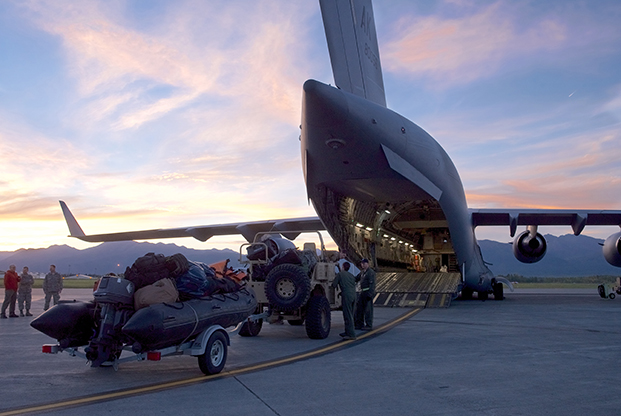
Search and rescue airmen and aircraft — such as this 144th Airlift Squadron C-17 Globemaster III — from the Alaska Air National Guard have deployed to Dover AFB, Del., as part of the "second echelon" of search and rescue ahead of Hurricane Florence's landfall. Air National Guard photo by David Bedard.
The military has 7,000 troops and dozens of aircraft on immediate standby, with thousands more ready to immediately deploy once Hurricane Florence makes landfall early Friday and begins to bring damage to the East Coast.
In addition to the 4,000 Guardsmen and 3,000 Active Duty forces ready, there are thousands of service members on prepare to deploy orders. This includes USAF search and rescue airmen and aircraft from the Alaska, California, and New York Air National Guard that have deployed to Dover AFB, Del., and are a part of the “second echelon” of search and rescue.
Storm response is a “no fail” mission, and the US military is anticipating the needs of state and local responders by prepositioning search and rescue capabilities and relief supplies, USAF Gen. Terrence O’Shaughnessy, commander of US Northern Command, said during a Thursday briefing at the Pentagon.
First Air Force’s air operations center at Tyndall AFB, Fla., is ready to coordinate the response, which will include USAF HH-60Gs, HC-130s, and pararescuemen on alert at Moody AFB, Ga. This contingent includes both Moody’s forces and airmen and aircraft from Patrick AFB, Fla.
The USS Kearsarge and USS Arlington are ready off the coast to follow Florence’s path in and to launch rescue helicopters and MV-22 tilt rotor aircraft. US Army high-wheeled vehicles are standing by at locations throughout North and South Carolina, along with US Army helicopters in reinforced hangars at Fort Bragg, N.C., O’Shaughnessy said.
The Air Force is ready to launch an E-8C JSTARS to help coordinate the response, while the National Geospatial-Intelligence Agency will help provide situational awareness of affected regions.
Air Mobility Command also has aircraft on standby for storm response. The C-17s that evacuated to Scott AFB, Ill., from JB Charleston, S.C., ahead of Florence’s arrival, “are in Bravo lift status, which means they can get airborne here within about three hours after notification,” Col. Jimmy Canlas, vice commander of the 618th Air Operations Center (Tanker Airlift Control Center), told Air Force Magazine in a Thursday phone interview.
Canlas cited the strategic pre-positioning of evacuated aircraft as a lesson learned from last year’s “hurricane trifecta of Maria, Harvey, and Irma.”
The military has “surrounded the affected [the] area with DOD capability” that is ready within the “first minutes” after the storm hits, O’Shaughnessy said.
Kenneth Rapuano, the assistant secretary of defense for homeland defense and global security, said during the briefing that Defense Secretary Jim Mattis approved dual status commanders in North Carolina, South Carolina, and Virginia to coordinate both Guard and Active Duty responses. The Pentagon is “fully engaged” with the Federal Emergency Management Agency, and has pre-approved the use of any military forces for life-saving actions, he said.
